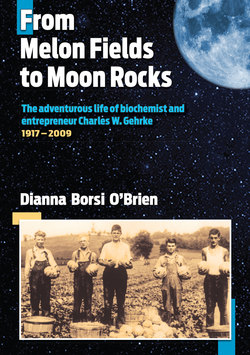Читать книгу From Melon Fields to Moon Rocks - Dianna Borsi O'Brien - Страница 17
На сайте Литреса книга снята с продажи.
ОглавлениеChapter 14
A Day in the Experiment Station
Charles set up his schedule to encourage interactions with students, chemists and other professors and researchers, allocating set times, as outlined as follows:
8-9:30 a.m. – Secretary, dictate letters, reports, other duties
9-10:30 a.m. – Meet with Paul Rexroad, assistant manager of the Experiment Station, and other leaders of projects
10:30-noon – Committee meetings
Noon-1:30 p.m. – Lunch at home and rest
1:30-3 p.m. – Meet with graduate students
3 p.m. – Research or walk through the laboratories
3-4:30 p.m. – Sign letters, return calls
4:30 p.m. – Pick up children from the university laboratory school
8-10 p.m. – Research and writing at university office
Former students and workers recall that Charles always took time to talk to his students and fellow researchers, but the talk was always about research and focused on problem solving. Charles wasn’t one for chitchat or asking about someone’s family while on the job, said Kaiser and others. Charles maintained a fixed focus on work in the laboratory.
Stalling attributes this trait to Charles’s background. The first time he met Charles, Stalling realized he reminded him of his own father, who, like Charles, had grown up on a farm during the Depression. He saw in Charles his father’s same constant drive to perform and produce: “Charles was very goal oriented, very outcome oriented.”
For Charles, work didn’t end at five o’clock or at the office. Like his high school mentors, Charles went beyond guiding the students’ work and studies. He provided additional opportunities, taking students to national meetings, pushing them to make presentations, and introducing them to the movers and shakers in their fields.
For example, Robert Zumwalt recalled attending a scientific conference and meeting Carl Sagan, Stanley Miller, and Harold Urey, a 1934 Nobel Laureate in Chemistry. Urey and Miller were the scientists who conducted the classic experiment in 1953 on the origins of life, finding that life could spring from inorganic compounds, under the proper conditions.
“There I am, twenty-four years old, and I’m sitting next to Carl Sagan,” said Zumwalt, who joined the Experiment Station staff in 1966 and worked with Charles on the Moon soil samples and for decades afterward. “These were the people I’d read about in scientific journals.”
Charles, and the jobs he offered, helped a lot of graduate students, many of them from rural backgrounds, and this education opened doors, said Zumwalt.
“He gave a lot of people opportunities. He let us see windows into a wider world,” said Zumwalt, who grew up on a farm in southwest Missouri. “I met him when I was twenty-one years old,” he said, and in five years he found himself with a PhD, working with NASA. Zumwalt would go on to become one of Charles’s most constant work companions and scientific colleagues, later traveling to Europe with him and co-editing a book.
The Bad With the Good
Charles’s strong personality, his perfectionism, and his intense drive to meet the goal of streamlining the laboratory’s operations could lead to conflict, many of his former students and colleagues agreed.
“Charles would push you to achieve those objectives,” said Ussary. He recalled one graduate student arguing with Charles that, while his research failed to produce a solution for analyzing a particular fertilizer component, the negative results also provided useful information. At the time, Ussary said, Charles was less than interested in that message—although it was a lesson he’d learn later when he analyzed the Moon rocks.
Ussary said other graduate students didn’t want to struggle for perfect results and instead simply wanted to finish up and move on. But Ussary said Charles wouldn’t accept anything less than a student’s best. Charles was relentless about learning, and he expected this same kind of drive in his students. Charles was promoted to full professor in 1954 but still sat in on other professors’ lectures and classes from time to time. “I wanted to learn,” he said.
Kaiser and Ussary said Charles pushed his students to write, to write well, and to have their work published. “We had to get published,” recalled Ussary—preferably in peer-reviewed journals. Ussary said Charles was an extremely critical editor. Before desktop computers, editing and corrections meant the entire paper had to be retyped. Ussary said he could recall only one student whose thesis wasn’t torn apart. His peers envied him. “At the time it was frustrating,” Ussary said, “but we learned.”
Kaiser agreed. “I had taken technical writing and excelled at it, but I could always guarantee it wouldn’t make any difference; Charles would always rewrite and rephrase, and later he might even rephrase his rephrase.” Having worked with Charles from 1962 to 1968, first as an undergraduate student and then for his Master’s Degree under Charles’s direction, Kaiser recalled, “You never ever got anything through without some comments, rewording.”
Working with his students, often with the students as first author, Charles had more than 270 scientific refereed papers published in scientific journals. He also wrote ten published books.
Kaiser said the training held him in good stead later when he became the ABC Labs business-development principal. The job called for developing client proposals and bids, and he found himself doing the same thing Charles did—rewriting and rephrasing his own writing and that of his subordinates.
But if Charles was a harsh taskmaster, he also made sure his students had what they needed to excel. “We always had plenty of money,” said Ussary, which meant they also had the equipment they needed. Charles, he said, seemed especially talented at finding funding, “He seemed to have more than his share of grant money.”
As Stalling noted, when he visited MU in 1962, it was clear who had the “toys and the equipment.”
